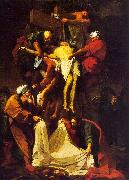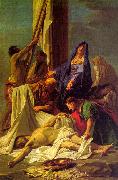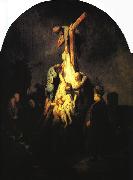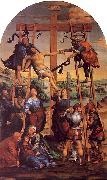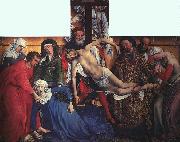
|
Jean-Baptiste Jouvenet
|
|||
|
|
|||
| 1644-1717 French Jean Baptiste Jouvenet Galleries He came from an artistic family, one of whom Noel Jouvenet may have taught Nicolas Poussin. He early showed remarkable aptitude for his profession, and, on arriving in Paris, attracted the attention of Le Brun, by whom he was employed at Versailles, and under whose auspices, in 1675, he became a member of the Acad??mie royale, of which he was elected professor in 1681, and one of the four perpetual rectors in 1707. He also worked under Charles de la Fosse in the Invalides and Trianon. The great mass of works that he executed, chiefly in Paris, many of which, including his celebrated Miraculous Draught of Fishes (engraved by Audran; also Landon, Annales, i. 42), are now in the Louvre, show his fertility in invention and execution, and also that he possessed in a high degree that general dignity of arrangement and style which distinguished the school of Le Brun. Jouvenet died on the 5 April 1717, having been forced by paralysis during the last four years of his life to work with his left hand. | |||
|
|
|||
|
The Descent from the Cross Jean-Baptiste Jouvenet3.jpg Painting ID:: 2095 |
1697 Musee du Louvre, Paris | ||
|
|
|||
|
Jean-Baptiste Jouvenet
|
|||
|
|
|||
| 1644-1717 French Jean Baptiste Jouvenet Galleries He came from an artistic family, one of whom Noel Jouvenet may have taught Nicolas Poussin. He early showed remarkable aptitude for his profession, and, on arriving in Paris, attracted the attention of Le Brun, by whom he was employed at Versailles, and under whose auspices, in 1675, he became a member of the Acad??mie royale, of which he was elected professor in 1681, and one of the four perpetual rectors in 1707. He also worked under Charles de la Fosse in the Invalides and Trianon. The great mass of works that he executed, chiefly in Paris, many of which, including his celebrated Miraculous Draught of Fishes (engraved by Audran; also Landon, Annales, i. 42), are now in the Louvre, show his fertility in invention and execution, and also that he possessed in a high degree that general dignity of arrangement and style which distinguished the school of Le Brun. Jouvenet died on the 5 April 1717, having been forced by paralysis during the last four years of his life to work with his left hand. | |||
|
|
|||
|
The Descent from the Cross Jean-Baptiste Jouvenet4.jpg Painting ID:: 2096 |
The Hermitage, St.Petersburg | ||
|
|
|||
|
Rembrandt
|
|||
|
|
|||
|
|
|||
|
The Descent from the Cross Rembrandt1.jpg Painting ID:: 3369 |
1633 Pinakothek, Munich | ||
|
|
|||
|
Giovanni Sodoma
|
|||
|
|
|||
| 1477-1549 Giovanni Sodoma Galleries | |||
|
|
|||
|
The Descent from the Cross Giovanni Sodoma3.jpg Painting ID:: 3805 |
c1505/10 Pinacoteca Nazionale, Sienna | ||
|
|
|||
|
WEYDEN, Rogier van der
|
|||
|
|
|||
| Netherlandish Northern Renaissance Painter, ca.1400-1464 major early Flemish master, known also as Roger de la Pasture. He is believed to have studied with Robert Campin. His early works also show the influence of Jan van Eyck. Van Eyck, however, had been a master at objective rendering of detail, whereas Roger in his work portrayed emotions with an assurance that has not been surpassed. His ability to depict piety is reflected in the early masterpiece Descent from the Cross (c.1435; Prado); he depicted with significant restraint the profound grief of the mourners grouped around the tragic figure of Jesus. His composition strongly affected later representations of the theme. Roger became City Painter in Brussels in 1436. He then produced a series of undated altarpieces including the Last Judgment (hospital, Beaune), the Braque Triptych (Louvre), Crucifixion with Donors (Vienna), and Adoration of the Magi (Berlin), which vary in execution from a stress on sumptuous details to a more sculptural rendering of the figures. Roger is believed to have made a pilgrimage to Italy in the holy year 1450. Whether this supposed excursion had any effect on his style is much debated. It has been shown that his Entombment (Uffizi) bears an affinity to the Tuscan treatment of the subject, particularly by Fra Angelico, and that Roger's Virgin and Child with Saints (Frankfurt) has a strong resemblance to the Italian religious art of the day. His style is, however, highly individual. His religious paintings and his portraits are characterized by a straightforward monumentality. The portraits, such as that of a young lady (National Gall. of Art, Washington, D.C.) and of Francesco d'Este (Metropolitan Mus.) exhibit a simple clarity of contour and psychological penetration. Other notable works are his St. Luke Painting the Virgin, of which a version or replica is in the Museum of Fine Arts, Boston, the Crucifixion | |||
|
|
|||
|
The Descent from the Cross new5/WEYDEN, Rogier van der_Vf6pAL.jpg Painting ID:: 19327 |
panel painting, 1435, Museo del Prado at Madrid | ||
|
|
|||
|
Also Buy::. For Following Paintings / Artists / Products, Please Use Our Search Online: |






